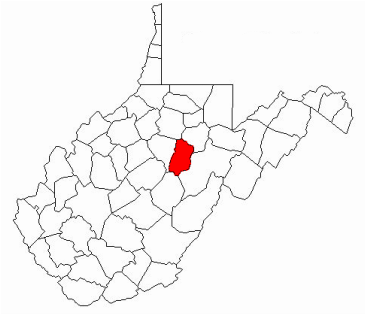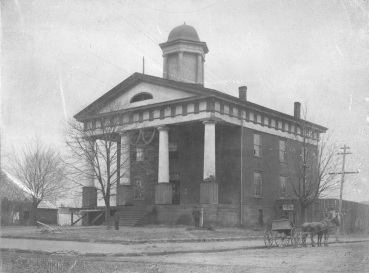Upshur County 1860s

When the Civil War broke out in 1861, Upshur County was just 10 years old, having been formed in 1851 from parts of Barbour, Randolph and Lewis counties among the Allegheny foothills in the northwestern section of Virginia. It was named for Abel P. Upshur, former Virginia judge who served as Secretary of the Navy and Secretary of State under President John Tyler. While serving as Secretary of State, Upshur was killed in a gun explosion during a ceremony aboard the USS Princeton on Feb. 28, 1844.
The county seat of Buckhannon contained about 600 residents and Upshur was home to 6,918 persons according to the 1860 census. Most were farmers, but the list included lawyers, tanners, millers, merchants, shoemakers, teachers, physicians, clergymen, blacksmiths, a dentist and several other occupations—even a music teacher and an artist. Flagstone sidewalks linked the 10 stores in Buckhannon. And mail was delivered each evening after arriving by stagecoach from Clarksburg. Many ancestors of the residents originally came from New England, and slaveholders made up only .75 percent of the Upshur County population.
The county seat of Buckhannon contained about 600 residents and Upshur was home to 6,918 persons according to the 1860 census. Most were farmers, but the list included lawyers, tanners, millers, merchants, shoemakers, teachers, physicians, clergymen, blacksmiths, a dentist and several other occupations—even a music teacher and an artist. Flagstone sidewalks linked the 10 stores in Buckhannon. And mail was delivered each evening after arriving by stagecoach from Clarksburg. Many ancestors of the residents originally came from New England, and slaveholders made up only .75 percent of the Upshur County population.

The first Upshur County Courthouse, 1850s.
Upshur County residents voted 701-306 against Virginia’s Secession Ordinance on May 23, 1861. By that time, a number of men already had been sworn into military service in the county on both the Union and Confederate sides. The Upshur Grays, sworn into state service on May 7, were to become one of the principal companies in the Confederacy’s 25th Virginia Infantry, which originally included many men from Upshur, Marion and Pendleton counties. Many men of the 25th were surrendered at Rich Mountain in July 1861 and when the regiment was reorganized in May 1862 it included not only the Grays and companies from Pendleton County but also companies from such Shenandoah Valley counties as Augusta, Highland, and Rockbridge.
Meanwhile, Upshur County contributed many men to such Union units as the 133rd militia (Upshur Blues), later absorbed by other Union units. Many from Upshur County were to serve in Battery E of the 1st West Virginia Light Artillery and the 10th West Virginia Infantry, both formed in 1862.
Most of my ancestors fought for the Union. These included Mearbeck Ours of the 1st West Virginia Light Artillery (4th Detachment of Battery E) and Levi Cross of the 10th West Virginia Infantry (Company H). Cross, who enlisted in Barbour County on June 20, 1863 (the day West Virginia became the 35th state of the Union) was wounded Sept. 19, 1864, at Winchester, Va., when his unit was directly across the field from the 25th Virginia.
Throughout the war Union troops generally received more and better equipment than their Confederate counterparts and, in most cases, a higher quantity and quality of food. Union soldiers from Upshur County also were able to stay in communication with the “home folk” much more consistently than were their Confederate counterparts. The latter were cut off by Union occupation of their home county during most of the war, and got back to visit family and friends only during a quick raid by Col. John Imboden in late April and early May of 1863.
Meanwhile, Upshur County contributed many men to such Union units as the 133rd militia (Upshur Blues), later absorbed by other Union units. Many from Upshur County were to serve in Battery E of the 1st West Virginia Light Artillery and the 10th West Virginia Infantry, both formed in 1862.
Most of my ancestors fought for the Union. These included Mearbeck Ours of the 1st West Virginia Light Artillery (4th Detachment of Battery E) and Levi Cross of the 10th West Virginia Infantry (Company H). Cross, who enlisted in Barbour County on June 20, 1863 (the day West Virginia became the 35th state of the Union) was wounded Sept. 19, 1864, at Winchester, Va., when his unit was directly across the field from the 25th Virginia.
Throughout the war Union troops generally received more and better equipment than their Confederate counterparts and, in most cases, a higher quantity and quality of food. Union soldiers from Upshur County also were able to stay in communication with the “home folk” much more consistently than were their Confederate counterparts. The latter were cut off by Union occupation of their home county during most of the war, and got back to visit family and friends only during a quick raid by Col. John Imboden in late April and early May of 1863.